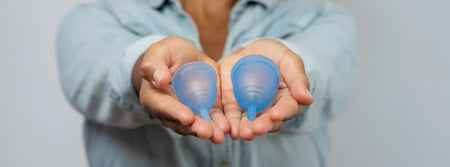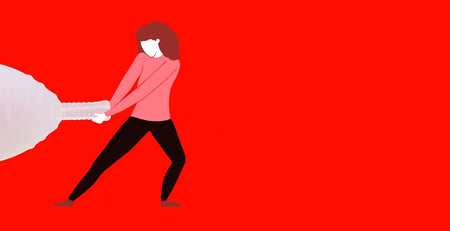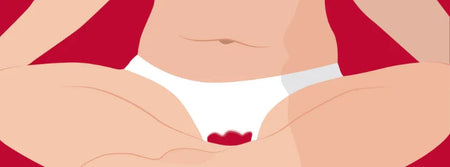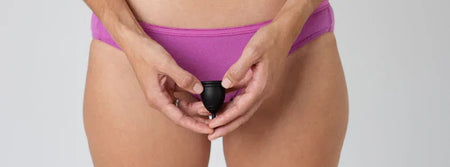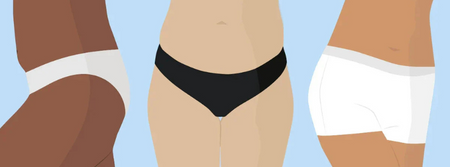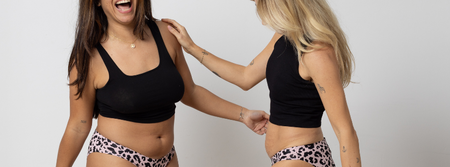This article was reviewed by medical professional Amy Harris, whom you can read more about at the end of the article.
It’s very common to be worried about using a menstrual cup if you have an IUD (Intrauterine device). A menstrual cup is held in place due to suction. On removal of the cup, this should, theoretically, dislodge the IUD, right? And how do you know if you’ve accidentally dislodged your IUD while removing your cup, or if it’s still there in your cervix?
Choosing a sustainable, reusable menstrual product shouldn’t result in an unplanned pregnancy.
Knowing how to insert and remove your Ruby Cup correctly can reduce your chance of dislodging your IUD. All the while remaining committed to a more planet-friendly period option, without worrying about pregnancy or your IUD.
If you’re in doubt about how to insert and remove your cup correctly, or merely wish to brush up on your knowledge, then read on for our expert guidance. The health experts at Ruby Cup know that when it comes to menstrual cups, practice makes perfect.
Want a zero-waste and fuss-free period? For every Ruby Cup purchased, we donate another one to a person without access to safe menstrual products. Get your Ruby Cup now.
What is an IUD?
An IUD is a device in a person's womb or uterus for either contraception or non-contraceptive health benefits. There are two types:
- A hormonal IUD coated in progestin. The progestin being released gradually at a steady level works to prevent pregnancy in two ways. First, progestin thickens the cervical mucus into a plug to block sperm. Second, progestin thins the lining of the womb, making it more difficult for eggs to successfully be fertilized and to implant. People who experience heavy or painful periods may choose the hormonal IUD to reduce their flow or eliminate it altogether.
- A non-hormonal IUD is wound in copper. The copper IUD interferes with the sperm’s ability to swim to and fertilize the egg. It’s the preferred IUD option for those who wish to choose non-hormonal contraception.
Both types of IUDs sit in the same place—inside your uterine cavity.
The IUD offers highly effective, long-acting, reversible contraception. Depending on which type of IUD you choose, it can protect you from pregnancy from 3 to 12 years.
Another reason people choose an IUD is to help with hormone imbalance.
An IUD is also easily removed when you decide you don’t need it anymore. And once it’s inserted, you don’t have to think about it again. No pill, no reminders, no waste.
Overall it’s a hassle-free, long-lasting, nearly 100% effective form of contraception.
And next, what is a menstrual cup?
A menstrual cup is a reusable period product. It’s made out of silicone and sits inside your vagina, below your cervix. Unlike disposal period products that absorb the blood and are then thrown away, you empty your cup, rinse it with water, and place it back inside your vagina to continue collecting period blood.
A menstrual cup is sustainable, eco-friendly, and can last up to 10 years. That’s the equivalent of 3,000 disposable pads or tampons. Each month you can contribute to a cleaner planet—and save money while you’re at it.
Using a cup isn't as messy as using the more traditional period products. You clean your cup yourself, you sterilize it yourself, and only you are touching it.
It’s a comfortable product for those who are athletic, especially for aquatic sports. People who are menstruating often avoid swimming pools during their periods fearing leakage.
Related post: Menstrual Cup Pain: Is It Normal & What Can You Do About It?
Can you use a menstrual cup if you have an IUD?
Short answer, yes, you can wear a menstrual cup if you’ve got an IUD.
As the diagram below displays, your IUD sits in your uterus and your menstrual cup sits in your vaginal canal. Your cervix separates them and they peacefully coexist. Think happy neighbors instead of overcrowded roommates.

Diagram showing where both the IUD and your menstrual cup sit
The most important way to prevent dislodging your IUD is to break the suction that holds your menstrual cup in your vaginal canal before pulling your cup down and out of your body. This is referred to as breaking the seal. Menstrual cups, like Ruby Cup, are specially designed to minimize this risk: perforated holes.
Does using a menstrual cup increase the risk of IUD dislodgement or expulsion?
Somewhere between 3-5 out of every 100 IUD-users expel their IUDs, regardless of whether they use menstrual cups. So, there’s always a small chance that your IUD will fall out, either by expulsion or dislodgement. Some people may be more likely to expel their IUD because they:
- Have heavier periods
- Are younger (less than 20 years old)
- Haven’t previously been pregnant or carried a pregnancy to term.
-
Their IUD wasn’t inserted in the correct place in their uterus.
There’s limited research looking at whether using a menstrual cup increases your risk of IUD expulsion or dislodgement. One recent study followed more than 1,000 women with non-hormonal IUDs for 3 years. The study, using the ParaGard IUD, found higher than expected IUD expulsion rates among menstrual cup users.
Don’t throw your Ruby Cup out the window just yet. As with many clinical studies, it’s important to look a bit deeper before jumping to any conclusions. Keep in mind that we’re talking about very small numbers here: out of the 266 people using menstrual cups, only 14 reported IUD expulsion.

Reasons why your IUD may get dislodged or expelled
Sometimes we worry less when we know what to try to avoid. That way you can proactively take steps to keep your IUD in the right place. Here are some of the reasons why your IUD might dislodge.
IUD strings got caught during cup removal
Your IUD strings hang down from your cervix into your vaginal canal. It’s possible for your IUD strings to get caught between the edge of your cup and your vaginal wall. With enough suction and downward pressure from removing your cup, you could also pull out your IUD. This might be more likely to happen if your cervix sits lower in your vagina. (more about this further down)
You experience heavy periods
You’re going to be using your cup a lot more if you’ve got a heavy period. Even though your menstrual cup can sit and collect your period blood for up to eight hours, you might feel discomfort and the need to empty it more often. This doesn’t mean that if you’ve heavy periods you can’t use a menstrual cup with an IUD.
Related Post: The 7 Best Menstrual Cups for Heavy Flow (No Leaks!)
Your cup is the wrong size
Two sizes are available from Ruby Cup, small and medium. You might choose a small cup if you’ve light periods, are younger, or your cervix is lower. Those who have gone through vaginal childbirth and/or have heavy periods may have less leakage and better suction with the medium size cup.
The cup has not been inserted correctly
It takes time to get used to inserting your cup. Everyone goes through this at the beginning, but don’t worry, we’re here to help. There are three different folding techniques to try.
Learning the different folding techniques for cup insertion and using a water-based lubricant can help you make sure your Ruby Cup is inserted correctly. After your first few cycles using a cup, you’ll become a pro. Still not sure? You can always pay a visit to your doctor and ask them to help you figure out how best to insert your menstrual cup.
Related Post: Where Should a Menstrual Cup Sit & How to Insert It
You don’t know the height of your cervix
Not every person knows the ins and outs of their most intimate anatomy. It’s completely normal to not know your cervix height, but it’s something that can be easily checked by your provider or yourself. Ruby Cup wants to teach you how to measure the height of your cervix. Your cervix height will determine how high to insert your cup, and what size cup will work best for you.
You’re removing the cup the wrong way
Removing your menstrual cup incorrectly is one of the biggest risk factors for dislodging your IUD. Remember the suction and the location of your strings that we mentioned before? Checking for your strings at the edge of your cup and breaking the suction before removal will keep your IUD safe and sound where it’s meant to be.

As the image above shows, pinching the base of the cup helps break the seal and removes any suction. If we all knew this before inserting the cup there would be less panic when trying to remove our menstrual cup.

An example of how completely normal it is to take time to get used to a menstrual cup.
How do you know if your IUD has been dislodged?
You may not be able to tell right away if your IUD is dislodged. You can try to feel for your IUD strings yourself—if you can feel them, then your IUD is still in place. If you can’t feel your strings, you’ll need to have an exam and possibly an ultrasound with your gynecologist. It’s a good idea to make a habit of feeling for your IUD strings before and after each period.
To check for the strings of your IUD, stick your finger up into your vaginal canal, like when you’re checking the height of your cervix, and feel around for the strings.
If you don’t feel your IUD strings:
-
Your body expelled your IUD.
-
The position of your IUD inside your uterus may have changed.
-
The strings may have curled up inside of your cervix
If you don’t feel them, make an appointment with your health provider and use an alternative birth control method. You can continue using your menstrual cup. There’s nothing major to worry about.
5 ways to safely use a menstrual cup if you have an IUD
Practice these simple techniques for a worry-free period.
1. Choose a menstrual cup with perforated holes.
Some menstrual cups, like Ruby Cup, are designed with perforated holes. These holes help you break the suction holding your menstrual cup in place, making it less likely that you accidentally pull out your IUD.
2. Use a flexible, soft menstrual cup
Cups made from materials like medical-grade silicone are easier to insert and remove. They bend easily and fit comfortably inside your vagina. Unlike more rigid menstrual cups, Ruby Cup is made from soft, hypoallergenic, medical-grade silicone.
3. Make sure you insert your cup correctly
We’ve already outlined how to use a menstrual cup. Inserting it can be done by squatting, or lifting one leg. Try out different positions and folding techniques to find the one that suits you.
Step one: Clean your hands and ensure your cup is sterilized for first use.

Step two: Fold the cup into a ‘c’ shape. Apply some water-based lubricant if needed.

Step three: Squat by bending your knees slightly to open up your vaginal canal. Insert your cup.

Or: you can bend one knee if it’s more comfortable than squatting for you.

Step four: After you’ve inserted your cup, try different positions like sitting down to test whether it’s in a comfortable location.

4. Check the position of your IUD strings
After you insert your cup make sure you can’t feel your IUD at the edge of your cup. The safest place for your IUD strings is hanging straight down into the cup.
You can always ask your health provider to trim your strings shorter. Your provider will be able to determine the ideal IUD string length for both safe menstrual cup use and IUD removal when the time comes.
5. Wait to use your menstrual cup until 2-3 months after you have your IUD inserted.
It takes between 2-3 months for your uterus to get used to having the IUD in place, so it’s during this phase when you’re more likely to dislodge your IUD. You’re less likely to accidentally dislodge it after this time so it’s going to be your best bet to wait until your uterus has adjusted to the IUD before using a menstrual cup. You should discuss any concerns about this with your healthcare provider.

What to look for in a menstrual cup when you have an IUD
Menstrual cups offer a great option for sustainable period protection and can happily cohabit with your IUD, especially if you look for the following when choosing your cup:
-
Choose the smallest size cup that still feels comfortable and doesn’t leak.
-
Select a menstrual cup with a shorter stem. You can cut the stem yourself if needed.
-
Perforated holes to help break the seal before removal.
-
A soft and flexible cup.
We’re very pleased to say that Ruby Cup offers all of these options. Our cups are hypoallergenic and are made from medical-grade silicone, so they are softer and easier to manipulate. And the crème de la crème: our cups have perforated holes.
We even go a step further and donate one cup for each one bought to where they’re needed to help eliminate period poverty. Regular reports are sent back to us so we can update information and improve the overall education to encourage people to choose a sustainable approach to period products.

Conclusion
Yes, you can safely use a menstrual cup if you have an IUD.
Choosing an IUD as a form of birth control, or for other health reasons, is the comfortable option. It also offers few side effects and the lowest impact environmentally. Why not seek the same qualities in your menstrual products and choose a menstrual cup as your preferred period product?
If you want to make the choice to be more sustainable with your period products, then having an IUD shouldn’t discourage you. Speak to your healthcare provider and ask them about your cervical height and which cup might be the best for you.
You can take control by educating yourself. By getting to know what will work best for your body, you can make the right choices for yourself.
While it might seem a bit more complicated when an IUD is involved, within a few cycles you'll be enjoying all of the benefits of both your IUD and your Ruby Cup.
FAQ
Is it safe to use a menstrual cup with an IUD?
Yes, menstrual cup use is safe with an IUD. Problems with IUD dislodgement are rare but talk to your doctor or midwife if you’re worried.
Can removing your menstrual cup dislodge your IUD?
You can safely remove your menstrual cup without dislodging your IUD by first breaking the seal, rather than pulling at the stem.
How soon can you start using a menstrual cup after you get an IUD fitted?
Healthcare providers suggest waiting a minimum of six weeks after you get an IUD. This allows ample time for your uterus to get used to the IUD and makes dislodgement less likely.
What to do if I can’t find my cup?
First of all, don’t panic. Many people have been in your exact situation before. Check out this article on how to remove your menstruation cup.
How do I know what size cup I need?
Check out this menstrual cup size guide to help you make an educated decision about which size is right for you.
Ruby Cup will walk you through finding the right menstrual cup with a helpful quiz.
Want a zero-waste and fuss-free period? For every Ruby Cup purchased, we donate another one to a person without access to safe menstrual products. Get your Ruby Cup now.
Reviewed by Amy Harris. Amy Harris is a certified nurse-midwife with more than a decade of clinical experience in reproductive health clinics, hospitals, and private OB/GYN practices. Amy holds a Masters of Science in Maternal and Child Health from Harvard School of Public Health and completed her nursing and midwifery training at Yale School of Nursing and Boston University School of Public Health. Passionate about empowering women through health education, Amy puts her public health training to work as a dedicated women’s health writer.





